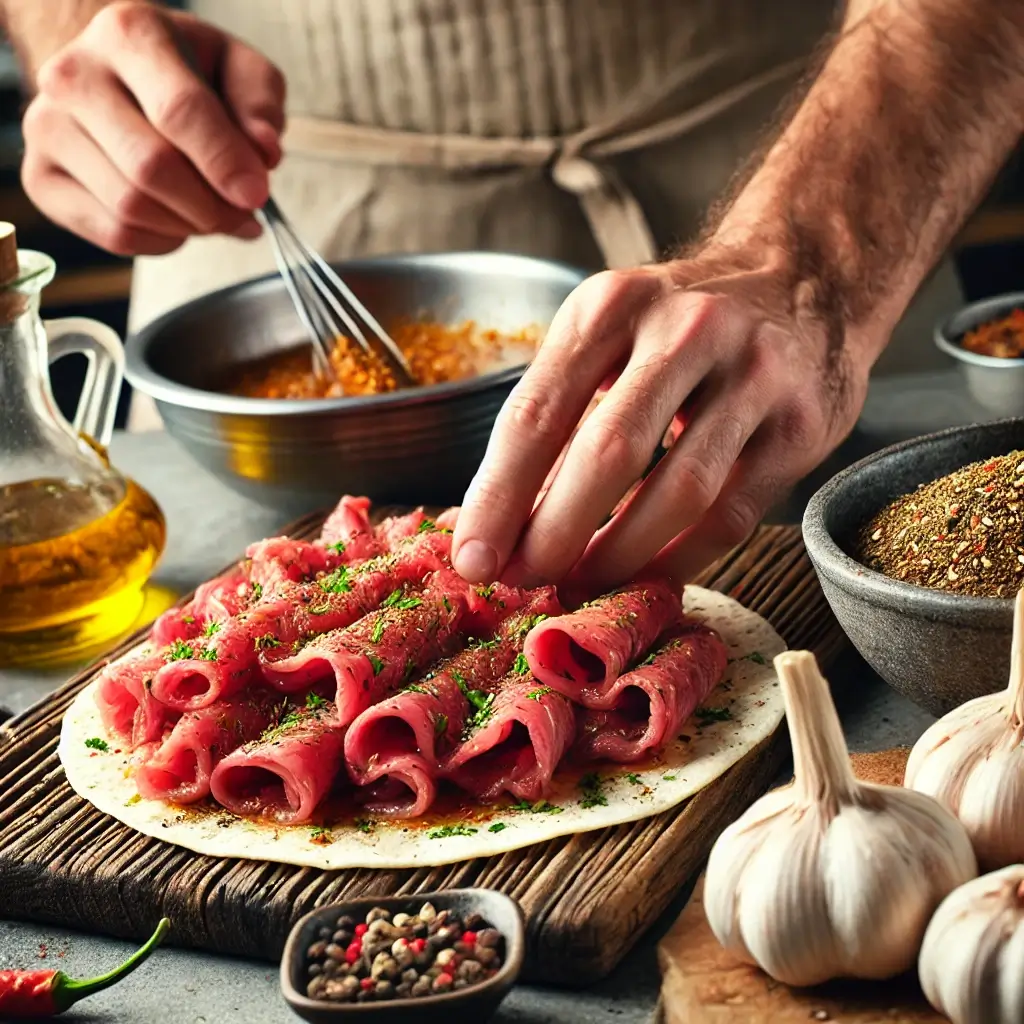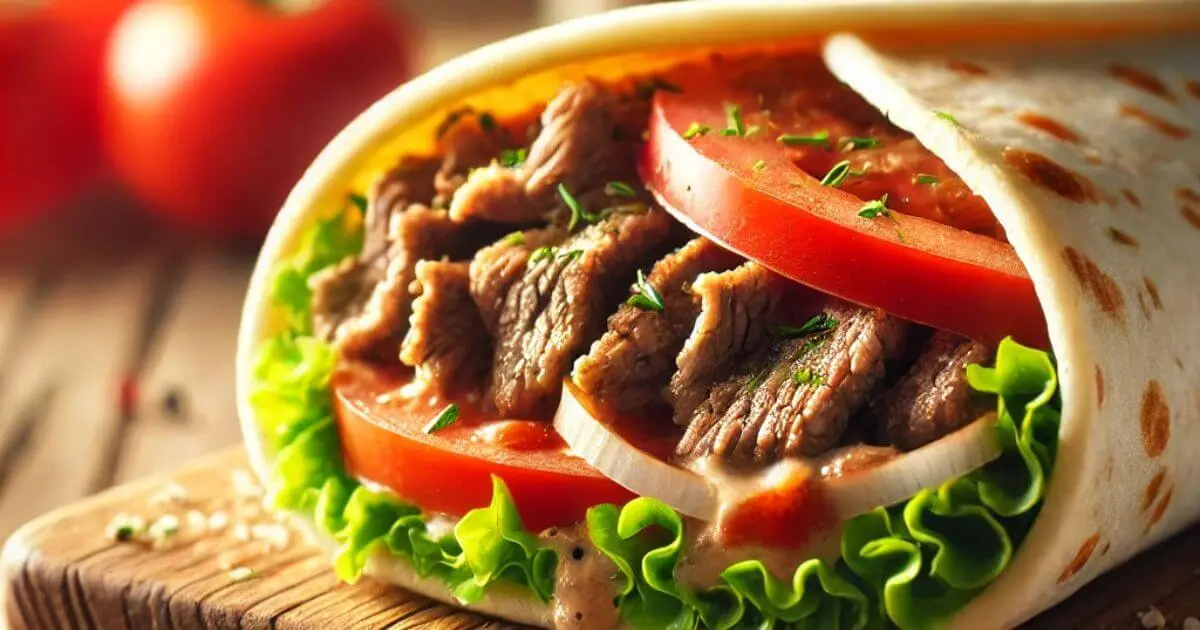Introduction to Beef Shawarma Recipe
The Origin and History of Shawarma
Shawarma is a popular Middle Eastern dish made from thinly sliced, marinated meat that is slow-cooked on a rotating spit. It has origins in the Ottoman Empire and has since spread worldwide, with each region adding its own twist. Traditionally, shawarma is made with lamb, chicken, or beef and served in wraps or on plates with various accompaniments.
Why Make Your Own Shawarma at Home?
Homemade beef shawarma allows you to control the ingredients, ensuring a healthier and more flavorful dish. You can customize the spice blend, cooking method, and toppings to your taste while avoiding preservatives and additives found in some store-bought versions. Plus, it’s a cost-effective way to enjoy this delicious dish anytime.
Table of Contents
Essential Ingredients for the Perfect Beef Shawarma

Must-Have Spices for Authentic Flavor
The key to a flavorful shawarma lies in the spice blend. Essential spices include cumin, paprika, coriander, garlic powder, onion powder, cinnamon, and black pepper.
| Category | Ingredient | Quantity |
|---|---|---|
| Marinade | Beef (sirloin or flank steak), thinly sliced | 1.5 lbs |
| Garlic, minced | 4 cloves | |
| Dried oregano | 1 tsp | |
| Cumin powder | 1 tsp | |
| Lemon juice | 3 tbsp | |
| Wrap | 4 pita bread or flatbreads | |
| Toppings | Various items as desired (see below) | |
| Toppings | Tomato, diced | 1 medium |
| Toppings | Cucumber, diced | 1 medium |
| Toppings | Red onion, thinly sliced | 1 small |
| Toppings | Fresh parsley or cilantro, chopped | ½ cup |
| Toppings | Garlic sauce or tahini | As needed |
When combined, these essential ingredients create a savory marinade that deeply flavors the beef. The wrap holds everything together, while the various toppings add freshness, making your beef shawarma truly exceptional. Collectively, they contribute to the overall experience of enjoying this delightful dish.
Tips for a Flavorful Marinade
Combine the spices with olive oil, lemon juice, and yogurt for a rich marinade. Let the beef marinate for at least 4 hours or overnight for the best results.
The Best Sides and Accompaniments (Bread, Sauce, Toppings)
Shawarma is best served with warm pita bread or flatbread. Popular toppings include pickled vegetables, lettuce, tomatoes, and onions. Traditional sauces like tahini, garlic sauce, or yogurt-based dressings complement the dish perfectly.
Step-by-Step Guide to Making Beef Shawarma
Step 1 – Preparing the Marinade and Marinating the Meat

In a bowl, mix the spice blend with olive oil, lemon juice, and yogurt. Coat the beef slices thoroughly and let them marinate in the refrigerator for at least 4 hours.
Step 2 – Cooking the Shawarma (Oven, Stovetop, Rotisserie)
- Oven Method: Preheat to 400°F (200°C) and bake the marinated beef on a lined tray for 20-25 minutes.
- Stovetop Method: Heat a pan over medium-high heat and cook the beef slices until browned and fully cooked.
- Rotisserie Method: If you have a vertical spit, stack the marinated meat and cook it slowly for an authentic shawarma experience.
Step 3 – Assembling the Shawarma Wrap or Plate
Slice the cooked beef into thin strips. Serve in a pita wrap with toppings and sauce, or plate it alongside rice, hummus, and salad.
7 Secrets to Enhancing Your Beef Shawarma
Creating the best homemade beef shawarma involves more than just following a recipe; it requires attention to detail in ingredient selection, cooking methods, and presentation. Here are seven essential secrets that will elevate your shawarma experience.
First, focus on the choice of beef. Opt for cuts such as sirloin or flank steak, which are known for their tenderness and flavor. The quality of the meat plays a pivotal role in the overall taste of the dish. Secondly, marinating the beef is crucial. A well-constructed marinade that includes yogurt, garlic, lemon juice, and a blend of spices such as cumin, coriander, and smoked paprika will not only tenderize the meat but also infuse it with rich flavors.
Third, consider the duration of the marinating process. Allowing the beef to marinate for at least 4 hours—or ideally overnight—ensures that the flavors deeply penetrate the meat. Another tip is to slice the beef against the grain. This technique ensures that each bite is tender and easy to chew, contributing to a satisfying texture.
When it comes to cooking, using a high-heat cooking method, such as grilling or broiling, enhances the flavor by creating a beautiful char on the outside while keeping the inside juicy. For the best results, aim for a temperature of about 450°F to 500°F. The fifth secret lies in layering flavors during the assembly of the shawarma. Start with a base of garlic sauce or tahini, followed by the sliced beef, fresh vegetables, and herbs like parsley or mint for added freshness.
Lastly, presentation is key to a memorable meal. Using warm pita or laffa bread, and garnishing with colorful ingredients not only makes the shawarma visually appealing but also enhances the overall dining experience. By incorporating these secrets into your cooking, you can create beef shawarma that delights the palate and impresses your guests.
Learn about the best cuts of beef for shawarma. (Best Beef Cuts for Cooking)
Serving Suggestions and Accompaniments
When enjoying beef shawarma, the right accompaniments can elevate the meal from satisfying to truly spectacular. Each component of the dish works in harmony to enhance the rich flavors of the marinated beef, ensuring a well-rounded dining experience. A variety of side dishes and dips can be introduced to complement this exquisite wrap.
One of the most popular dips to serve alongside beef shawarma is tahini sauce. This creamy, sesame-based sauce adds a nutty flavor which beautifully balances the savory spices of the shawarma. To make tahini sauce, simply mix tahini with lemon juice, garlic, and water until you reach a smooth consistency. The result is a delicious addition that not only enhances flavor but also contributes a lovely texture.
Garlic sauce, or toum, is another fantastic accompaniment. Its garlicky kick pairs wonderfully with the beef and can bring a bold, zesty element to the dish. Made from blended garlic, olive oil, lemon juice, and salt, this sauce should be served generously on the side, allowing diners to control the intensity of flavor in each bite.
Pickles are a classic addition that introduces a tangy crunch, providing a textural contrast to the tender beef. A combination of pickled cucumbers and turnips adds a vinegary bite that complements the richness of the shawarma quite well. For a refreshing touch, consider offering a simple salad, such as a tabbouleh or fattoush salad, filled with parsley, tomatoes, and cucumbers, which can brighten the palate.
Incorporating these dips and side dishes not only enhances the flavors of the beef shawarma but also encourages a more interactive dining experience, inviting guests to customize their wraps and explore different flavor combinations.
Popular Variations of Shawarma
Shawarma, a beloved street food originating from the Middle East, has undergone numerous adaptations around the globe. Each region has embraced this dish, resulting in a myriad of variations that reflect local tastes and culinary practices. One of the most recognized adaptations is the chicken shawarma, which, while retaining the characteristic spices of traditional shawarma, offers a lighter option for those preferring poultry over red meat. The seasoning typically includes garlic, cumin, and coriander, providing a distinct flavor profile that attracts chicken lovers.
Beyond chicken, lamb shawarma is another popular variation, particularly in Mediterranean regions. The rich, succulent meat is often paired with aromatic spices, delivering a robust taste that contrasts beautifully with fresh toppings such as tabbouleh or tahini sauce. This combination not only enhances the flavor but also provides a satisfying texture that complements the tender shawarma.
In many countries, such as Turkey, shawarma is often prepared using beef, which is marinated and cooked on vertical rotisseries. Beef shawarma boasts a rich flavor and is typically served with a mix of crunchy vegetables and homemade sauces, elevating the overall experience. Variations may also include unique toppings such as pickles, fried potatoes, or spicy sauces, contributing further to the culinary diversity of this dish.
As globalization continues to influence food trends, one can find an array of creative interpretations of shawarma. For instance, some chefs experiment with non-traditional ingredients, including fish or plant-based proteins, appealing to vegetarian and vegan diets. Moreover, regional sauces like tzatziki or harissa offer a twist, providing an unexpected but delightful flavor combination. The versatility of shawarma invites creativity in the kitchen, allowing home cooks to explore and enjoy diverse flavors while staying true to the culinary roots of this dish.
Conclusion: Enjoying Your Homemade Shawarma
Preparing beef shawarma at home is not merely a culinary endeavor, but a journey that leads to the creation of a dish steeped in tradition and bursting with flavors. The satisfaction derived from crafting your own shawarma wraps cannot be overstated, as it allows for personal customization that suits individual taste preferences. Whether you prefer your beef seasoned with classic spices or enhanced with fresh herbs and ingredients, the process can be tailored to create a truly unique dining experience.
Cooking at home brings a sense of control over the ingredients, ensuring that each wrap is made with high-quality, fresh components. This attention to detail not only enhances the flavor but also fosters a greater appreciation for the art of cooking. Moreover, the aroma that fills your kitchen while the beef is marinated and grilled creates an inviting atmosphere, prompting feelings of warmth and satisfaction.
As you gather the finished shawarma wraps for family and friends, you are not just serving a meal; you are sharing an experience that encourages connection and conversation. It is a delightful opportunity to introduce your loved ones to a dish that is cherished in many cultures around the world. Encouraging others to partake in the homemade shawarma journey can cultivate a sense of community and shared enjoyment.
We invite you to try out this beef shawarma recipe and explore the various ways to enhance it with your own creativity. Sharing your experiences, tips, and variations with others can inspire them to embark on their culinary adventure. By making homemade shawarma, you not only elevate your cooking skills but also create lasting memories with those you cherish. Enjoy the process, the flavors, and the delightful moments that come with each wrap. Your kitchen is now the gateway to a wonderful culinary tradition!
Frequently Asked Questions (FAQ) About Beef Shawarma
Can I Make Shawarma Without a Rotisserie?
Yes! You can cook shawarma in an oven or on a stovetop. The key is to slice the beef thinly and cook it at high heat to mimic the traditional method.
What Is the Best Way to Reheat Beef Shawarma?
The best way to reheat shawarma is in a skillet over medium heat. This helps maintain its juiciness and prevents it from drying out.
Can I Make Shawarma Ahead of Time?
Yes, you can marinate the beef in advance and store it in the refrigerator for up to 24 hours before cooking. Cooked shawarma can be stored in an airtight container and reheated as needed.
What Are Some Vegetarian Alternatives to Beef Shawarma?
You can use mushrooms, tofu, or jackfruit as meat alternatives. Marinate them with the same spice blend to achieve a similar flavor.
Have you tested our recipe yet?
There are no reviews yet. Be the first one to write one.

